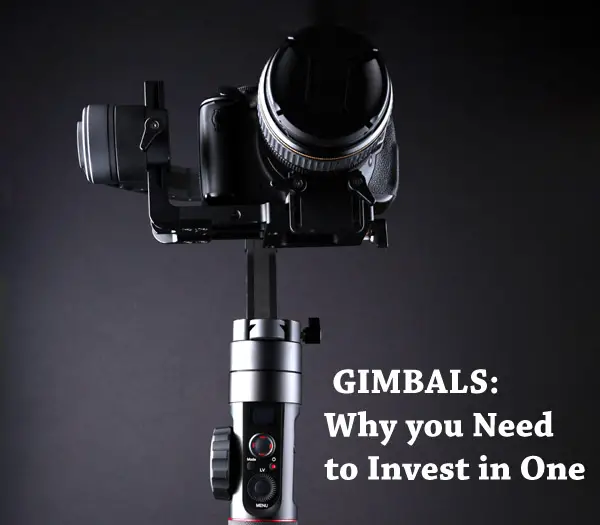A gimbal is a device that enables you to keep your camera stable while shooting video. It can also be useful when it comes to capturing high-quality still images. A combination of three gimbals will enable you to obtain a smooth movement of your handheld camera in three different directions, thanks to the three rotation axes.

In this article I will go over the benefits and limitations of gimbals, their uses, and tips for using a gimbal for both still images and videos.
Five great benefits I get from using a gimbal:
1) Smooth Tracking Shots, Steadicam-Style
This is probably right where your mind goes as soon as I mention camera gimbals. You can use the device to get the camera in motion, follow your subject, and create a tracking shot. To minimize vertical bobbing, do your best to keep your subject centered in the frame while you move. The further off-center you let your subject drift, the more the viewer’s eye is drawn to the edge of the frame where up-and-down movement is more noticeable.
2) Tilt And Pan Smoothly, Without A Tripod
A gimbal can make a very serviceable substitute for a tripod. This is particularly handy on fast-paced guerilla-type shoots, where you simply might not have the time to set up a tripod or move it around. Your camera gimbal allows you to produce the same sort of pans and tilts you could get with a tripod mounted camera. This can be done without even touching the joystick on the gimbal. Practice moving the gimbal and camera along with your body.
3) Shoot Steady Stills, Handheld
Even when you take movement out of the equation entirely, a gimbal can be tremendously useful. It can cut down greatly on camera shake during still shots, again, just like a tripod. To get the best results, you will need to make an effort to hold yourself still. If your shot comes out with relatively minor movements, you can use a warp stabilizer to minimize them.
4) Push Overs / Sliders / Slow Dollies
If I break my filming down shot-by-shot, this is probably what I use my gimbal for the most. It allows me to create a smooth slider-like movement, easily capturing a basic push over. By relying on a gimbal for this, I free myself from the need to haul a dolly or slider around.
5) Crane Shots
This is one of my favorite “trick” gimbal shots. I simply squat down with the gimbal and camera and then raise myself up slowly and smoothly. The result is a neat small-scale version of a crane up shot that requires no extra equipment.
Why Use A Gimbal With Your Camera?
A gimbal helps you prevent camera shake while you move
Before gimbals were invented, camera operators could only move around their camera by holding it in their hands or on a sturdy tripod. Now, due to gimbals, they can make steady movement shots wherever they need. The small size and the excellent portability of these devices make them much better than older and massive camera rigs. You may want to make sure that the gimbal will work with your camera, for example, look at the best gimbal for sony a6000.
You can use a wide range of motions
Setting up a particular shoot can take a lot of time when you need multiple movement tools. A gimbal allows you to move your camera in any direction without the need for complex tools and equipment.
You can save energy
A gimbal isn’t as heavy as other props, so it enables you to save your energy while offering you the freedom to move as you wish. Operating a camera with a gimbal is more comfortable and more convenient than any other stabilization solutions and accessories available today.
Limitations
There are a few limitations you have to know about before deciding to use a gimbal to shoot professional videos. Read about a few of them here, below.
Gimbal Limitations
Gimbals can’t replace professional equipment
Gimbals are great at stabilization, but they can’t replace professional equipment required to create high quality videos. There are some cinematic tools a gimbal can’t replace. These tools include dollies, jibs and sliders. However, if you weren’t going to use such accessories anyway, a gimbal can help you create beautiful footage with impressive motion stability by eliminating camera shake. If you aren’t a professional movie maker, a gimbal is the perfect tool for you.
Your creative potential matters
You can buy all the tools in the world and still fail at creating great videos if you lack creative skills. You should ensure that you use your creative potential to the fullest before deciding to buy a new device. A gimbal won’t help you create more catchy videos. It is only a tool to help you keep your camera stable.
Gimbals don’t control vertical movement
The smooth tilt, roll and pan on three axes provided by gimbals has nothing to do with the vertical movement of the camera. This is something you should learn how to control yourself, if you want to obtain the great results you’re after.
Other Tips On Making The Most Out Of A Gimbal
You can rotate or invert gimbals as you want
The natural handling of a gimbal requires you to hold it close to your body, near your chest or waist. However, if the situation calls for it, you can invert the gimbal to get the best shot.
Learn how to properly balance your gimbal
For best results, you have to know how to balance your gimbal. Even the greatest videographer of all will fail at getting that perfect shot if the gimbal isn’t properly balanced. When you balance your gimbal, you make it more responsive, you use less battery power, and you protect your device by not overworking its motor.
5 Uses For A Camera Gimbal + General Gimbal Tips
I’ve spent a couple of months now on an international tour that’s allowed me to film lots of different subjects. I’ve done commercials, mini-docs, and narrative pieces. Through it all, one thing that’s become clear to me is that my single-handed gimbal might be the second-most important piece of gear I’ve got, second only to my camera in importance.
A hand-held gimbal is crucial for capturing run-and-gun video, and the small size of a gimbal makes it a tremendously versatile tool. I don’t think it’s an exaggeration to say that every filmmaker would be better off learning how to use this resource.
That’s why I put together this basic tutorial on using a camera gimbal. Explore the full range of possibilities and find out what sort of stable, eye-popping footage a gimbal can deliver for you. Let’s dive right into the action!
Tips to Take your Gimbal to the Next Level
* Get Your Camera Balance Right: This is a foundational skill for using a gimbal. You need to be able to balance your camera properly to get the best results. If you haven’t mastered it yet, you can expect to see weird shakes in your footage as the gimbal’s motors work constantly to recalibrate.
* Get the Camera Moving: You’re just not going to get the most out of your gimbal if you don’t use it for its intended purpose. Move around! But remember you don’t need to be leaping and running. A gimbal can deliver great results from small, subtle camera movements, like tracking and panning shots.
* Make Your Foreground Exciting: Film remains a 2-dimensional medium, so part of our job is taking steps to create depth in our footage. Foreground elements do a lot on this score, and using a gimbal allows you to create parallax effects by moving the camera in relation to those elements.
* Get Closer: With a gimbal, you can get up close and personal without losing stability. Try a close-in orbital shot!
* Compose Your Shots: Don’t let yourself run too wild with your new toy. You may stumble accidentally onto great footage, but planning out your work improves your odds considerably. Ask yourself exactly what you want to capture, and then build a plan to do it.
I hope that I have peaked your interest in gimbals, both for shooting video with your dSLR and stills. Let me know if you have any questions below.
For more tricks to shooting steady shots without a tripod, click the link.
Photodoto https://ift.tt/2Lfnznq
Sourced by Time Trap Photography sharing the best photography tips, news and tricks throughout the industry.


Sourced by the Time Trap Photography guys https://ift.tt/1LW7xnO
Time Trap Photography is dedicated to freezing those special moments in life that can be revisited and admired for generations to come.





No comments:
Post a Comment
Thank you so much for your comment. A moderator will review and approve all relevant posts. We appreciate your support and encourage you to stay with us by subscribing to our email updates. Where you can easily pick and choose what photography subjects interests you. Subscription link: http://bit.ly/photo-sub